#cross-strait chinese
Text
Tricky words that differ between 普通话 and 国语
Usually tone and other small pronunciation differences between 普通话 and 国语 don’t phase me much. In context I don’t even notice 期望 qīwàng vs. qíwàng. But recently I stumbled across 颤巍巍 and realized that it’s a lot harder when both/all syllables in a word are pronounced differently!
Here are 8 words (including 颤巍巍) that sound pretty different in 普通话 and 国语 (definitely not exhaustive).
Format: 简体(繁体)普通话读音 | 国语读音
Simp. (Trad.) Putonghua pron. | Guoyu pron.
【1】 颤巍巍(顫巍巍)chànwēiwēi | zhànwéiwéi - trembling / swaying / flickering / tottering / faltering
【2】 血液* xuèyè | xiěyì - blood
【3】 差劲(差勁)chàjìn | chājìng - bad / no good / below average / disappointing
【4】 熟识(熟識)shúshi or shúshí | shóushì- to be well acquainted with / to know well
【5】 血迹*(血跡)xuèjì | xiějī - bloodstain
【6】 垃圾 lājī | lèsè - trash / refuse / garbage / of poor quality (this is probably the most well known difference!)
【7】 倏地 shūde | shùdì - swiftly / suddenly
【8】 惋惜 wǎnxī | wànxí - to regret / to feel that it is a great pity / to feel sorry for sb
Definitions are from MDBG.
*The pronunciation of 血 is all over the place. You can hear xuè, xuě, or xiě. I’m generalizing here, but I actually tend to say xuě.
Under the cut you can see some bonus words that I found (I didn’t include them since I have not seen/learned them).
【9】 夹击(夾擊)jiājī | jiájí - pincer attack / attack from two or more sides / converging attack / attack on a flank / fork in chess, with one piece making two attacks
【10】 突击(突擊)tūjī | tújí - sudden and violent attack / assault / fig. rushed job / concentrated effort to finish a job quickly
【11】 削发(削髮)xuēfà | xuèfǎ - to shave one's head / fig. to become a monk or nun / to take the tonsure
【12】 综括(綜括)zōngkuò | zòngguā - to summarize / to sum up
【13】 敛迹(斂跡)liǎnjì | liànjī- to refrain / to give up evil (temporarily) / to cover one's traces / to lie low / to retire (from view)
【14】 档期(檔期)dàngqī | dǎngqí - slot within a schedule / timeslot (for a TV program, a session with a photographer etc) / range of dates in which an event is to be held (film screening, exhibition etc)
【15】 质朴(質樸)zhìpǔ | zhípú - simple / plain / unadorned / unaffected / unsophisticated / rustic / earthy
【16】 血泊 xuèpō | xiěbó - pool of blood
【17】 稍息 shàoxī | shāoxí - (military) Stand at ease!
See similar posts:
Who knew! These characters are pronounced differently in Taiwan
Cross-strait tone differences
#cross-strait chinese#langblr#language learning#mandarin chinese#studyblr#mandarin#chinese langblr#chinese#mandarin langblr#chinese language#learning languages
95 notes
·
View notes
Text
i think it's good practice to say DPRK/ROK and PRC/ROC because it is very useful and important to remember that those states are (at least on paper) making mutually exclusive claims to being the sole legitimate government of a proposed unitary area (korea/china) to understand their foreign policy and mutual relations
#the roc's territorial claims are just a legal fiction#tattletxt#yeah but that legal fiction has historically been important to cross strait peace#so it's probably important to remember they exist and the context between there being two self professed chinese states
49 notes
·
View notes
Note
im trying to ask this in good faith but why should china want the taiwan island? that is also been this way for a long time. why should it matter?
im from a country whose borders were redrawn smaller during the soviet time, but no one talks about the areas lost to modern russia and that we need to regain that land.
Do they want the island itself apropos of any other context? Probably not. If the island were part of Japan or the Philippines or had historically been an entirely independent nation, then while there may be other non-territorial conflicts I wouldn't imagine China would be too interested in taking over the island.
The fact is that Taiwan is unceded Chinese territory and the ROC has not controlled Taiwan for a "long time". The KMT retreated to Taiwan at the end of 1949. The modern Taiwanese independence movement started in the 1990s. The Chinese Civil War never formally ended. There is a long-standing ceasefire between the PRC and the ROC, but they have never signed a peace treaty and both sides still formally claim sovereignty over the entirety of China.
Within the ROC itself, there is still a major division between proponents of Chinese unification and proponents of Taiwanese independence. While support for secession and independence has grown in recent years, neither side can claim that they are representative of the interests of the people of Taiwan as a whole. This is why despite having been in power for nearly 10 years now, the DPP still hasn't initiated any formal processes towards independence. The country is still called the "Republic of China" and its constitution still claims the entirety of China as their rightful territory.
The PRC is committed to peaceful reunification and rejects any notion of Taiwanese secession or independence. They view such movements as regional unrest within territory that they rightfully have jurisdiction over, and are opposed to any foreign interference in Chinese affairs. They have never considered the ROC or Taiwan to be a sovereign nation and reject any interpretation of cross-Strait affairs that asserts such a view.
Like I said in my previous post: there is a difference between territory ceded to another sovereign nation via treaty and unceded territory that is occupied by the losing side of a civil war.
257 notes
·
View notes
Text
To B With Love: The One With The Honey Moon
I had a lot of fun learning about 19th century San Francisco and thought folks might like to see where Steve & Billy spend their bonding retreat.
If that interests you at all, more beneath the cut.

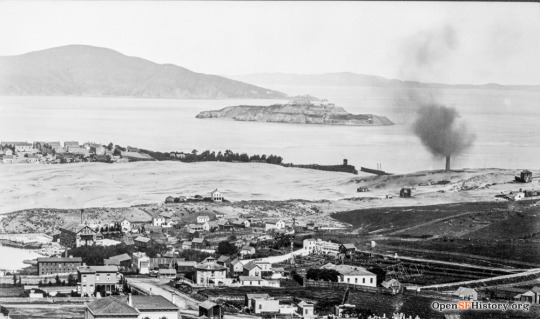
(Cow Hollow 1870)
Bordering the marina district on the bay, Cow Hollow is still a neighborhood that exists in the city today, and parts of it can be seen in The Princess Diaries, which is irrelevant but dear to me.
When the first settlers arrived with the gold rush it was called Spring Valley, known for the numerous freshwater springs that fed into the fertile lagoon, as well as for grassy meadows and sand hills inhabited by wildlife. All those grassy meadows were great for farming, and the area came to be known as Cow Hollow after its many immigrants took to lucrative dairy farming. The price of milk was high in the city at that time and a local farmer could easily support a family on dairy production.
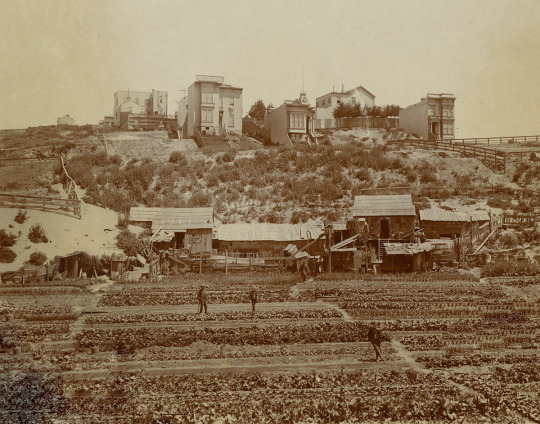
Cow Hollow (Chinese vegetable farm 1883)
Its main thoroughfare, was until the early 20th century an unpaved road which linked the developing city with the Presidio. As San Francisco rapidly expanded the area prospered and became a fashionable district for Prominent San Franciscans. They came and built their fancy houses and shops and businesses followed them. From about the 1860s to the late 1870s there were your standard gentrification tensions between the farmers and the fashionable set, which ended when the city banned cows in the area in the 1880s, effectively ending farming in the area for good.
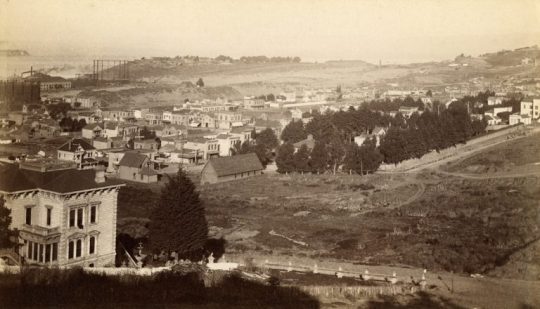
Cow Hollow (The Attorney General's private estate ensconced by trees)
Perhaps in defiance people continued to call it Cow Hollow, and good on them for that.
This neighborhood makes a lot of sense to me as a place Steve's cousin would have picked to hide him, as it is "comfortable", but not as congested as the city proper as well as close to the bay if a quick retreat is needed by boat.
*Bonus view of the Golden Gate strait from the Crissy field shoreline 1870

The same view in 2015
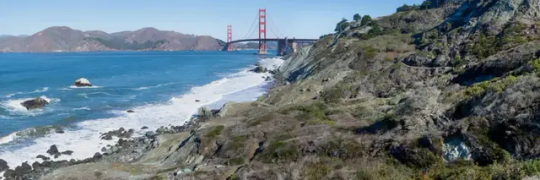
The house Billy & Steve stay in is described as an octagon shaped cottage, with a cross gabled roof and wrap around porch. Octagon shaped houses were a hot fad for "forward thinking individuals" in the 19th century that started with this doctor who published a bunch of papers, detailing his research into the human body and how the enlightened individual could use their environment to live their best life. Apparently, the flow and function of the octagon shape was superior in his book. Anyway, thanks to him and the trend setters we now have a nice collection of historical houses with this quirky, not all that functional shape. There's a full list online but I'll just include a few that were built around the 1860s
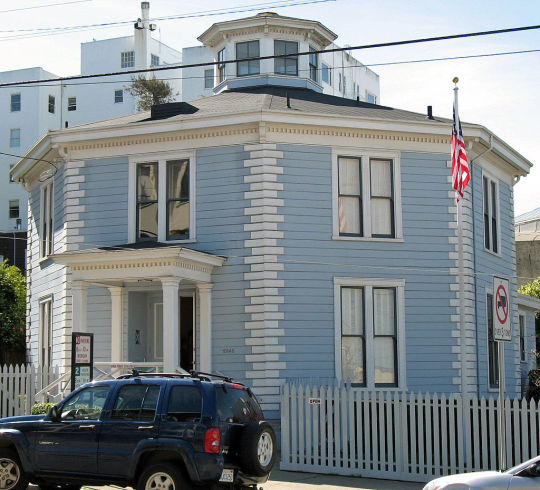
(McElroy House - San Francisco)

(New Jersey: super cute but I can imagine the tiny, weirdly cornered rooms just by looking at it)

(San Francisco: some modern updates obviously but I love the roof work)




(Not sure where these are)
And the one I used a direct reference for Steve & Billy's little retreat.

I love the gables, the porch, just everything. I can picture it on a hill with a view down to the bay, and I loved the idea of them being able to just follow a road to the sea.
That was the first image that came to my mind when I was outlining - the boys hand in hand on their way to the beach. Disheveled, not quite 'done up' all the way but no one to see them if they did. Just being young and starry eyed for each other. Frankly they deserve it after all I put them through lol.
#harringrove#billy hargrove#steve harrington#fic related things#to b with love#visual post#the honey moon spot
26 notes
·
View notes
Text
Taiwan FAQ [Updated 2024/5/26]
[See the 5/28 updated here]

[Photo credit CNA/Taiwan News]
[Image ID: A large crowd of Taiwanese protestors, many holding signs in Chinese displaying their criticism of current legislative goings on. Rather than focusing on individuals, the photo focuses on the size of the crowd. The crowd fills a wide avenue and disappears into the horizon. There are hundreds, perhaps thousands, of people pictured. /. End ID]
As Taiwan continues to strive to protect its autonomy and democracy, it is my goal to spread accurate, firsthand information about its current events worldwide with the aid of reblogs from people who also support democracy.
Here is a list I’ve compiled of basic questions and answers, and more importantly, further reading to help worldwide English speakers to understand Taiwan’s history and current situation.
One of the biggest weapons the PRC (China) is currently using right now is misinformation meant to confuse international audiences and deter support of Taiwan (ROC). I find it INCREDIBLY important that we start doing all we can to fight that.
FAQs
Acronyms/political parties explained (PRC/ROC/KMT/TPP/DPP)
How new is democracy in Taiwan?
Is Taiwan a part of China?/Does China control Taiwan?
Is Taiwan recognized internationally?
What was the Wild Lily Movement?
What was the Sunflower Movement?
What is the Bluebird Movement? / What is going on right now? / What are the details of the legislative reforms the KMT/TPP are trying to pass?
Why does the Bluebird Movement matter so much?
What is the Legislative Yuan?
Important names to know in the LY
Can the president veto these reforms?
Is the Bluebird Movement focused on China’s recent military actions?
What has China been doing militarily in recent years?
What did President Lai recently say to provoke China?
Is it illegal for foreigners to protest in Taiwan?
Should foreigners protest in Taiwan?
How to use Chinese-language resources as an English-speaker/Keywords to search in order to do so
What can I do to support Taiwan from abroad?
Further Resources
Talk from 5/25 on the current situation
Politics of Taiwan on Wikipedia (Government of the Republic of China on Wikipedia)
Post-WWII History of Taiwan on Wikipedia
Cross-Strait Relations on Wikipedia
Brian Hioe, journalist on Twitter (New Bloom Magazine)
Aurora Chang, activist on Twitter
Erin Hale on Twitter
James Hsieh on Twitter (Chinese-language)
Autum Huang on Twitter (Chinese-language)
It’s important to note that a lot of recent mobilization has been happening on Threads but I am not active there
Taiwan Plus (English news)
Taiwan News (English news)
CNA Focus Taiwan (English news)
TVBS World Taiwan (English news)
When reading global news media about current events in Taiwan, I urge you to look into an article/tweet’s author, their country of origin, and where they are based
Here’s the Taiwan tag on my blog
35 notes
·
View notes
Text
"Call me by my real name"
Taiwanese indigenous peoples are fighting to use their indigenous names on government IDs, rather than their Chinese ones:
115 notes
·
View notes
Text
In 1999, American bombers accidentally blew up China’s embassy during an attack on Belgrade, killing three. The Chinese reacted with outrage, demanding reparations and official apologies. To prove their seriousness, they made nationalist speeches that whipped Chinese citizens into a frenzy, culminating in tens of thousands of protesters throwing rocks and encircling the U.S. embassy in Beijing.
For Chinese leaders, this was par for the course. In responding to international crises, China long hewed to a simple playbook: stoking anti-foreign protests to show resolve and pressure the other side to desist.
But today, something has changed: Chinese leader Xi Jinping, hardly averse to invoking nationalism when it suits him, has nonetheless eschewed stirring up frenzied protests when facing international crisis. During the biggest foreign-policy crisis for China in decades, House Speaker Nancy Pelosi’s 2022 visit to Taiwan, Xi did not encourage Chinese protests—in fact, nationalist fervor was met with online repression, including a temporary shutdown of social media. Instead, the People’s Liberation Army (PLA) carried out a series of unprecedented exercises to punish Taiwan and redraw the cross-strait status quo.
Xi’s avoidance of anger on the Chinese street is not a one-off. In the past decade under Xi, crises have not abated but accelerated—yet they’ve been matched by the effective absence of anti-foreign protests in the streets and frequent displays of military force. The reasons for Xi’s shift away from protest bargaining are multifaceted, rooted in domestic politics and a preference for showing strength both at home and abroad. The result of a new crisis-signaling playbook is a China that shows resolve in crises not through anger in the streets but through warplanes and the fleet.
Chinese leaders, facing wave after wave of crisis over the past three decades, have long turned to protests to bargain. The turn of the century brought not just Belgrade but the 2001 EP-3 incident, where a lethal collision between planes resulted in Chinese diplomats threatening their U.S. counterparts with the rage of the Chinese streets if appropriate amends were not made. Throughout the 2010s, China and Japan feuded repeatedly over the status of the Diaoyu/Senkaku Islands, most notably in 2012, when Chinese government-stoked protests in reaction to the Japanese government’s purchase of the islands from private hands resulted in thousands of protesters engulfing 85 Chinese cities.
Jessica Chen Weiss, in her groundbreaking study of Chinese protests, examined more than 80 orchestrated protests in the quarter century preceding Xi’s ascension to power. She argued that protests are China’s attempt to do what economist Thomas Schelling called “tying hands”—increasing bargaining power by showing that one can’t back down.
Just as democratic leaders can point to polls as proof they’re fenced in at home, China can allow protests to rage in the streets to show the people will turn on it if it doesn’t get its way. China’s opponent will fear the effects of unrest that could become regime-threatening instability; considering the alternative, just letting Beijing have its way is preferable.
Yet few, if any, examples exist of Xi stoking anti-foreign protests during his tenure as president. In fact, he has worked actively to suppress such protests. While prior Chinese leaders frequently leveraged domestic protests as bargaining tools, Xi is hesitant to use nationalist uproar as his default option. Instead, Xi is more comfortable showcasing the PLA’s military power in major coercive demonstrations while suppressing nationalist movements at home.
To the extent that the people have mobilized under Xi, it has been for government-orchestrated “boycotts” that attempt to pressure other countries economically. Genuinely outraged Chinese citizens were discouraged from physically protesting during the deployment of a THAAD missile defense system in South Korea in 2017. Instead, Chinese consumers were encouraged to boycott the major retail conglomerate Lotte, which eventually drove the South Korean company out of China.
The new approach can be explained by several shifts within China over the past decade.
First, China’s leadership has changed. Xi is as confident about his nation’s strength as he is paranoid about the stability of his rule. As China’s unchallenged chairman of everything, Xi has consolidated control over all facets of Chinese society, presiding over the decimation of collective leadership, anti-corruption campaigns that have neutered elite opposition, and a massive surveillance network.
But this is not compatible with bargaining through protests, which inherently involves both telegraphing and accepting political vulnerability, requiring Xi to suggest that his power has limits and can be imperiled. Stoking protests constitutes evidence of Xi’s precarity among the elites or the population and is too risky to accept. Xi, knowing that his road to absolute control was paved with the ouster of all rivals, has installed himself as ruler for life; for such a leader, the prospect of being ousted is legitimately existential.
Second, China’s approach to foreign policy has changed. In previous decades, protests were an appropriate tool for reacting to a crisis foisted upon China, a weaker country telegraphing to the other side that it needed to cease the unwelcome behavior.
Xi Jinping, however, has moved away from former leader Deng Xiaoping’s mantra of “hide and bide” as China has grown increasingly powerful. Old territorial disputes have been dusted off: China has attempted to expand control of the South China Sea, harassed India on the countries’ shared border, pushed Japan in the East China Sea, and exerted unrelenting pressure on Taiwan.
Many of these disputes amounted to “crises”—only this time, they were initiated by China, making domestic protests a less effective tool to coerce weaker countries compared to military harassment by air and sea.
China, due to its rapid growth, also no longer sees protests as useful for telegraphing domestic weakness. China used to self-identify as a non-threatening developing country, and protests were helpful in advancing this image; the United States had no reason to worry about China dominating Asia when the country couldn’t even control its own streets. Yet today’s China advertises itself as a real power, proclaiming that Mao Zedong made Chinese people stand up, and Deng made them rich, but only Xi made them strong. This strong China is at the center of what Xi calls the rise of the East and the decline of the West. Such a country is not liable to be brought to its knees by anger in its streets.
The young people who make up the bulk of protestors are also a more volatile tool than in the past. From the May 4, 1919, demonstrations onward, Chinese university students have historically been reliable sources of nationalist anger directed at Japanese or American imperialists. But today, China’s younger generation lives in what has been called “an age of malaise,” confronting a whirlwind of economic and political problems ranging from slower growth to a collapsing real estate sector and widespread youth unemployment. Young adults are motivated more by frustration over the COVID-19 pandemic’s aftermath or the desire to “lie flat” in the face of persistent joblessness, hardly concerns Xi wants to be vocalized.
The protests today have also simply lost effectiveness as a bargaining tool. China’s successful deployment of the method relied on it credibly tying its own hands, suggesting that leaders bucked public opinion at their own peril. But if China can simply ignore or suppress protests, or is perceived as capable of doing so, there is not much credibility in hand tying and, thus, in the threats.
Xi’s success in concentrating power at home has accomplished just that. Improvements in the effectiveness of the repressive domestic apparatus have removed any credible constraint that could be believed by a foreign country. Xi’s tenure has intersected with a remarkable revolution in surveillance and censorship technology, with the world as its witness. Over the past 10 years, China has built the most monitored society ever: Eight of the 10 most surveilled cities in the world are Chinese; of the world’s billion surveillance cameras, half are in China. Online, private group chats are constantly monitored by algorithms and live agents, with real-world arrests frequently made.
As such, Xi’s campaign to centralize power and muffle opposition has eliminated any collective action that can be even remotely considered regime-threatening and, along with it, any prospect that protests could be used as a bargaining instrument. While previous Chinese leaders could reasonably point to popular or intra-political constraints, akin to an American president tied down by the U.S. Congress or polls, the omnipotent chairman of everything will struggle to convince others of his impotence.
The 2022 White Paper protests, set against a decade of popular passivity, were a clear moment of assertiveness and the most forceful domestic demonstration against Xi. But foreign onlookers saw that even the worst case for Xi—unrest spurred by something as aberrational and impactful as COVID-19 policy—could nonetheless be contained. If so, then smaller displays, such as anti-foreign demonstrations outside embassies, undoubtedly can be managed too. The alacrity with which China managed the White Paper protests has also fed the perception that they were a one-off: Protesters themselves were surprised by the degree to which China responded and held participants responsible, with one noting that “it’s going to be very difficult to mobilize people again.”
At the most basic level, Xi’s increased emphasis on military displays means international crises will run a greater risk of accidents. Military exercises, missile launches, and close encounters at sea or air are not risk-free, given the proximity in which the U.S. and Chinese militaries operate in the Pacific. If each military crisis is a roll of the dice, more crises mean rolling the dice more frequently—with more opportunities for something truly catastrophic to happen.
But more fundamentally, repeated military crises prime both sides to always reach for the military option, viewing anything less as a weakness and a retreat. Should China try to telegraph to the United States that its interests are at stake, the United States, well-accustomed to displays of force, may assume China’s response is cheap talk, absent a coupling with something more muscular. Consider the Pelosi visit in 2022. Xi’s repeated verbal warnings were dismissed as a bluff, and the United States persisted, which boxed Xi into sweeping military displays: a simulated blockade of Taiwan, firing a ballistic missile over the island, and commencing what has now become regular incursions of the Taiwan Strait’s median line.
In an ideal world, policymakers on both sides would recognize the dangers created by Xi’s new playbook and actively work to limit crises. Given the deep-seated interests involved on both sides, this is unlikely. But even without behavioral changes, policymakers would benefit from recognizing that assumptions from previous decades of crisis management no longer hold. This should provide the impetus for renewed stability dialogues: discussing redlines to avoid flashpoints, sharing insights on how each side views crisis management to manage disputes, and building firebreaks to contain incidents that risk spiraling out of control.
The alternative is continuing down a dangerous path, where future crises begin where the prior ones left off and Chinese leaders feeling pressure to not just repeat but one-up their previous response. Once a line has been crossed, uncrossing it appears weak and unthinkable. But as both sides climb the escalation ladder, fewer rungs will remain. As noted in these pages, this creates a new normal that leaves both parties living on the “edge of chaos”—permanently.
3 notes
·
View notes
Text
July 11 - Taipei
What a week! It's hard to believe that it's Thursday already. Even though I checked into our hotel last night, I am still jet lagged, tired, and feel stiff. I also met some others from my group in the airport, so I was less alone than I thought. I even went exploring with two people that I met on the flight!
This morning, I had breakfast at our hotel. I have never eaten food like what I ate this morning. I am not exactly sure what the name of everything is, but it wasn't bad - just very different from a classic American breakfast. Our group had a buffet dinner tonight to celebrate our first day, and once again there were so many new things. The sweet items have a different type of sweetness than the US- it tastes more like what I would expect from a natural sweetener. With the exception of fried food, everything here feels just a little bit lighter. They also serve the option of rice with every meal.
We all have MRT passes now, which lets us travel on the Taipei metro (and other select areas) for the next 30 days. Today we traveled to the older part of the city. This area is closer to Danshui River, where the city originated. There are many young people in this part of town. They have a large building called "Party World" nearby that is mostly just karaoke - they take it very seriously, like people practice days before. Taiwan is also the first and only Asian country to legalize same sex marriage and continues to be a country with many freedoms that rival those of the US. The support, especially in this part of the city, was very evident.
We also visited a daoist temple and the nearby night market (it was not night when we went, they were still setting up). The temple was dedicated to Mazu, goddess of the sea. When the first settlers of Taiwan came from China, crossing the Taiwan Strait was a dangerous feat. People pray to her because it is thought to grant them protection and good luck. I have never been to a temple like that. People wait in lines to pray while their incense slowly burns. Taiwan has never had religious conflict. Everyone is very accepting and that's pretty cool. I suspect this is because of the external conflict that plagues Taiwan. People have to come together to learn to live with different rules - they don't have the energy to bicker about internal affairs like religion. Our tour guide mentioned that with four generations, his family speaks four different native tongues: Japanese, Taiwanese, Mandarin Chinese, and English. I think that speaks to the trauma Taiwan has faced on a global scale, particularly because it has been pawned off to many countries.
Today, I learned a lot. It's only the first day, and I will be learning so much more too. I'm very tired, but I will make my first official post tomorrow!





2 notes
·
View notes
Text
Generally, there are three categories [of factions within the KMT]. The first group, led by chairperson Eric Chu, argues that engaging with the United States while maintaining a good relationship with China will make Taiwan safe. The difference between this KMT faction and President Tsai Ing-wen’s cross-strait policy is that Chu and believe sticking to the “1992 Consensus” is the “key” to communicating with Beijing – regardless of the fact that Chinese leader Xi Jinping has declared that the 1992 Consensus means “both sides of the Taiwan Straits belong to one China and will work together toward national reunification.”
This stance on the cross-strait relationship is not acceptable to the bulk of voters from both the KMT and Tsai’s Democratic Progressive Party (DPP). KMT and other pan-Blue voters are of the opinion that Chu’s China policy is too similar to the DPP’s, while pro-Green supporters regard Chu and others as “giving up Taiwan’s sovereignty.” Thus, these leaders have received little support in almost every poll.
The second group in the KMT has a more pro-mainland stance, asserting that the KMT should keep its distance from the United States in order to not frustrate the Chinese Communist Party. They believe that diplomacy, rather than deterrence, is the way to keep the Taiwan Strait safe. To achieve that goal, proponents like former President Ma Ying-jeou insist the Taiwanese government should explicitly state that it agrees with the 1992 Consensus as the foundation for further communications and cooperation.
This community within the KMT has more popularity than all the others, as it claims to offer another way to achieve peace, while proclaiming that it can perform better than the DPP in terms of economic welfare since they are capable of establishing better economic ties with China.
The last group within the KMT mainly consists of veterans and their descendants and is the least popular subgroup within the party. After having retreated from the mainland in 1949, this group of KMT members are die-hard supporters of reunification with China, as they still regard China as their home.
Given the “median voter theorem,” we might expect the KMT’s China policy will ultimately shift toward somewhere between the first and the second group. Yet the situation has not unfolded as the theory supposed, due to the structures and mechanisms within the KMT.
After retreating from China, the KMT veteran community established branches of the Huang Fu-hsing, a highly united group that loyally backed the political leaders who came over with them from China. Huang Fu-hsing members still firmly believe that ultimate reunification is the best option. Although their stance on cross-strait affairs is extreme compared to Taiwan’s general public, Huang Fu-hsing branches represent roughly 25 percent of the party member vote, and reportedly have a meticulous mechanism to allocate all their votes to serve various political aims. As a result, the organization became a comparatively strong power within the KMT.
Found this article that talks about internal KMT politics when it comes to relations with China and i find it interesting how it’s basically goes from “Appease both the US and China” to “Appease China even if at the expense of relations with the US” and then “Chinese nationalists whose priority is unification with the PRC“. And the third faction is basically veterans and the military (who you might naively assume would be the most pro-US but actually the opposite is the case) who are pretty unpopular but internal KMT politics are arranged in such a way that they have massively disproportionate sway and always vote as a unified bloc.
51 notes
·
View notes
Text

China’s J-20 Isn’t A “Dominating Aircraft,” USAF General Says
Oliver ParkenPUBLISHED Sep 13, 2023 7:00 PM EDT
Chinese J-20 aircraft on the runway
PLAAF
General Kenneth S. Wilsbach, the head of Pacific Air Forces, has offered new comments regarding China’s growing fleet of J-20 stealth fighters. Compared to the capabilities of the U.S., and those of its allies and partners, the general says that the J-20 does not constitute a "dominating aircraft at this point" — a statement which is broadly in line with insights he made on the type last year.
Wilsbach’s remarks were given at the 2023 iteration of the Air & Space Forces Association's annual symposium ongoing just outside of Washington, D.C., which The War Zone is attending. The only operational stealth fighter within the People's Liberation Army (PLA), the J-20 first flew in 2011. Precisely how many of the type have been produced since that time remains unclear, although best available estimates suggest somewhere in the region of 160-200 airframes.
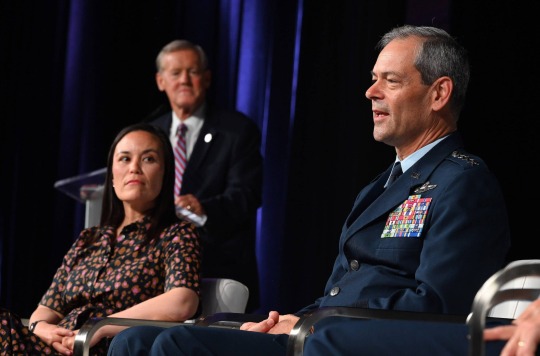
Under Secretary of the Air Force Gina Ortiz Jones and Gen. Ken Wilsbach, Pacific Air Forces commander, participate in a panel called “Preparing for Global Competition” during the 2022 Air and Space Forces Association’s Air, Space and Cyber Conference in National Harbor, Maryland, September 19, 2022. U.S. Air Force photo by Tech. Sgt. Nick Wilson
"I don’t think that it’s a dominating aircraft at this point, compared to what we have [in terms of stealthy F-22 Raptors and F-35 Lightnings]," Wilsbach highlighted. "They’ve done some good copying… pretty much most of the technology from that airplane [the J-20] was stolen from the U.S."

Chinese J-20s on the runway. PLAAF
Wilsbach was unequivocal in his conviction that the capabilities of U.S. aircraft, combined with those of allies and partners, could counter any potential threat from J-20s. This multi-national coalition of partners, which regularly trains with high-threat scenarios in mind, would prove extremely difficult for any Chinese aircraft to counter, according to the general.
"What I will tell you is if you compare just aircraft to aircraft, you take the training that our people [U.S. Air Force] get. Interoperability with [U.S.] allies and partners… the Chinese [are] probably still at a pretty big disadvantage because of the way we train, especially with [our] Korean allies and partners."
"[For the Chinese] a fight that would be China versus us [the U.S.]... that makes their math pretty easy, but if you make it China versus the U.S. plus the other countries… their math gets pretty hard to do… When I think about some of the recent exercises that we've done together with our allies and partners like Talisman Sabre, and Northern Edge, [and] Valiant Shield earlier, you know, there's some extremely high-end exercises that are happening. In the past, when we've done some of those large coalition-type exercises… the level of complexity is reduced, so that everybody can participate. We're not doing that. We're making it a high-end, if you want to play you show up and you execute."
"And so I've used the example of last year, in [exercise] Pitch Black… we had almost 20 nations participating in a night[time], high-end surface-to-air missile take-down … It was super complex, and everybody that was playing, which may surprise some of you some of the nations that were playing in the exercise, but it was really well done and well executed. And we're seeing that exercise after exercise."

Two Chengdu J-20s at Airshow China 2016. Alert5 via Wikimedia Commons, CC-BY-SA-4.0
Wilsbach was also pressed on the potential threat J-20s could pose for Taiwanese forces at the symposium, and how Taiwan would defend itself, if China were to conduct a military intervention across the Taiwan Strait. U.S. military officials have suggested that the PLA may be in a position to successfully execute a cross-strait intervention by 2027, if not sooner. For Wilsbach, the Chinese threat against Taiwan shouldn’t be pigeonholed to the J-20:
"They [Taiwan] have to have systems to be able to [prevent] the J-20… By the way, the J-20 is limited in my view to Taiwan. What is a major threat is the other aircraft that can come in and drop, draw their weapons on Taiwan, you know like their H-6 bombers, and then not to mention all the ballistic missiles and cruise missiles. So, you know, if I was Taiwan, I wouldn't be overly concerned with the J-20 at this point… they need to be concerned about it, but there's a lot of other things that they also need to defend themselves against to be that tough target we spoke about earlier." That is quite the statement as Taiwan’s most advanced fighter is the F-16V, with additional new-build Vipers on the way. Other upgrades are in play for the other fighters in its inventory. The island’s ever-evolving ground and sea-based integrated air defenses are also a factor here.
As Wilsbach himself indicated, his most recent assessment of the J-20 is broadly in line with the comments he made at the 2022 iteration of the Air & Space Forces Association's annual symposium. At that event, the general noted how J-20s "weren’t anything to lose a lot of sleep over," but that, "Certainly, we're watching them [China] closely and seeing how they… operate them." This viewpoint was supported by Air Force Chief of Staff General Charles Q. Brown, who was also speaking at the 2022 symposium: "Well, I'm like General Wilsbach… [The J-20 is] not something to lose a lot of sleep over, but I'm gonna pay attention to it."

Two J-20s break formation, November 2018. emperornie via Wikimedia Commons, CC-BY-SA-2.0
It should also be noted that Wilsbach has cited concerns with other Chinese aircraft in discussions on the J-20 in the past, too, including long-range command and control capabilities such as the KJ-500 airborne early warning and control aircraft. As we’ve noted previously, KJ-500s are regularly used to support combat aircraft flying sorties around Taiwan. In general, China has rapidly expanded its airborne early warning and control aircraft fleet while the U.S. has decreased its own, although the addition of the E-7 is now on the horizon.
If senior U.S. Air Force officials remain only moderately concerned by the rise of China’s J-20s, this likely has much to do with the capabilities that service will leverage in the not-too-distant future. Currently, the Air Force is developing various air combat capabilities under the Next Generation Air Dominance (NGAD) framework. This includes work on a sixth-generation crewed combat aircraft, various tiers of uncrewed platforms, as well as new sensors, weapons, and battle management systems. Lockheed Martin and Boeing are currently competing for the crewed combat aircraft contract, with Northrop Grumman having recently removed itself from the running. The Air Force hopes to pick a winner in 2024. Older 4th generation fighters are being reduced in numbers, but are also receiving critical upgrades and new ones with unique capabilities — the F-15EX — are being added to the fleet, as well. Meanwhile, the F-22 and F-35 fleets are the ‘tip of the spear’ of the USAF’s tactical aviation roster.
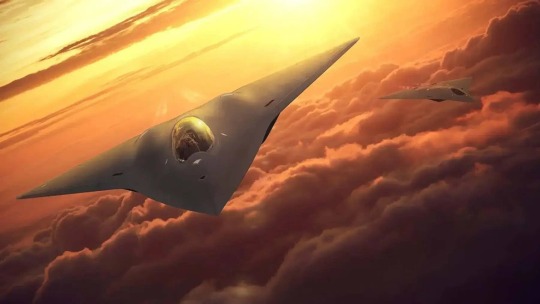
Lockheed's crewed component of NGAD. Lockheed Martin
With that said, the recent comments from Wilsbach clearly reinstate confidence that the U.S., alongside its partners and allies, retain the technological advantage over China’s current fighter aircraft designs.
Contact the author: [email protected]
9 notes
·
View notes
Text
Welcome to linghxr
For my 250th post on this blog, I created a new pinned post to introduce myself!
About me:
I’m a Chinese American learning Mandarin Chinese to connect with my family and heritage.
I started learning Chinese at a young age but became more serious about it in college. My native language is English.
Interests: Cpop/Mandopop, Chinese idol survival shows & reality singing shows, cdramas (mostly suspense/mystery/crime genres)
My top resources:
Pleco Chinese dictionary app
Anki flashcard software & mobile app
MDBG Chinese dictionary
教育百科 Chinese dictionary
Zhongwen browser extension
Readibu app
Chinese Grammar Wiki
Chinese Zero to Hero YouTube channel
每日中文课Free To Learn Chinese YouTube channel
If you are on my blog, click the tags below to see posts on topics I often post about!
#vocab list#chinese names#chinese resources#chinese music recs#chengyu#my watchlist#my learning#nerdy language stuff#culture stuff#cross-strait chinese#study tips and advice
397 notes
·
View notes
Photo

Chinese destroyer Suzhou (DDG 132) crossing the bow of USS Chung-Hoon (DDG 93) in the Taiwan Strait
11 notes
·
View notes
Note
about taiwan. but im still confused as to why should china care. they havent controlled taiwan for some time and seems to just cause conflict. why not just leave taiwan be and be happy with the mainland. what good does claiming taiwanese island bring? why do they care if an island belongs to them or not?
What good does the ROC claiming the mainland bring? Why does the KMT care about the ROC being the legitimate successor to Sun Yat-sen's Republic? Why is the DPP bribing right-wing US warhawks and inviting US destroyers into the Taiwan Strait?
This is not a situation where a bunch of nasty evil communists are persecuting an innocent island nation. This is a situation where a right-wing counter-revolutionary army, upon losing a civil war, occupied the island and maintained a military dictatorship for 45 years, only eventually opening up to democracy after massive amounts of protests and unrest. The PRC was the only democracy in China for those 45 years. They were fighting to liberate the Taiwanese people, not to oppress them.
After the ROC abolished the military dictatorship and repealed the law declaring the CPC to be rebels and enemies of the nation, the CPC and the KMT began to engage in peaceful dialog, leading to the 1992 Consensus. This consensus formed the basis of informal PRC-ROC relations, under the shared belief that Taiwan is a territory of China.
The election of the pro-independence DPP in 2016 has threatened the prospects of peaceful reunification. Unlike the KMT, the DPP has never had any relations with the CPC and is firmly opposed to reunification. Cross-Strait dialog between the two governments was cut off and the ROC quickly began to take a much more antagonistic role towards the PRC.
The PRC does not want a war. The Taiwanese people do not want a war. The KMT does not want a war. It is only the DPP and a bunch of US imperialists who have been bribed by the DPP who want a war. This is why the PRC has condemned foreign interference in Chinese affairs and condemned the separatist movement in Taiwan.
The PRC does not even want political control over Taiwan. They have proposed a "one China, two systems" approach to reunification that would enable the Taiwanese government to maintain its current legal system and operate with a high degree of autonomy. They know that the Taiwanese people would not soon accept CPC control over the island and they are not proposing that as a solution. But if the separatists get their way and start the Civil War all over again, it's very likely that that is what will happen, with many innocent lives lost to boot.
The DPP could choose at any point to resume the peaceful cross-Strait dialogues that the KMT had been engaging in. But they would rather continue their nonsensical rhetoric and wordplay where they can have their cake and eat it too; where the 1992 Consensus was never a consensus and where Taiwan is already independent despite never having declared independence. More worryingly, they want to continue courting US imperialists and engaging in behavior intended to provoke armed conflict in the region. They would rather start a war than risk having to acknowledge Taiwan's status as a territory of China.
If you want to understand the PRC's position better, this publication by the PRC is a good summary of their current position on the subject.
400 notes
·
View notes
Text
Dapenkeng culture in Taiwan, dating back 4,500 to 6,000 years, is the oldest-known Austronesian culture on the island and its residents were widely considered the ancestors of their counterparts living across the Pacific Ocean. Nonetheless, Kwang-chih Chang, a late, renowned archaeologist from Taiwan, put forward a theory that sources of Dapenkeng culture came from the Chinese mainland.
According to Zhou, a comparison between prehistoric sites in Taiwan and new findings along the Fujian coast further supports Chang's theory.
For example, the numerous newly unearthed pottery and stone artifacts on the Fujian island feature high similarity with patterns and decorations at the site in Taiwan.
"In spite of geographic proximity to the ocean, people from both places adopted a similar economic form: They not only relied on fishing for a living," Zhou explained. "We can find that agriculture played a more and more significant role as times changed until its importance equaled that of fishing. That can prove the frequent interactions across the Taiwan Strait at that time."
A botanical study conducted by scholars from the mainland and Taiwan, which was released in 2022, showed that rice and millet were introduced to Taiwan from present-day Fujian about 4,600 to 4,800 years ago.
"The spread of agriculture echoes the routes of human migration," Zhou added.
More molecular biology studies also provide clues to unveil such prehistoric cross-Strait links.
From 2011 to 2012, archaeologists from Taipei-based Academia Sinica found two human remains, estimated to be 7,500 and 8,200 years old, from Liangdao, an islet only 24 kilometers from Fuzhou. Follow-up anthropological studies unveiled their nature as the earliest-known Austronesian people with a close link to early residents in Taiwan.
In 2020, Fu Qiaomei, a researcher from the Institute of Vertebrate Paleontology and Paleoanthropology with the Chinese Academy of Sciences, led another group of researchers in comparative DNA analysis of the so-called Liangdao Man and ancient remains in a cave of Tanping, Fujian. They were genetically found to belong to the same group of people.
Zhou emphasized that related studies should widen the horizon as the spread of Austronesian peoples could be "more than a singular route". Sites in other coastal provinces including Zhejiang, Guangdong and Hainan are thus included in the origins-tracing program.
3 notes
·
View notes
Text
Chiang Wan-an was a teenager when his father sat him down to tell him about his heritage: he’s the great-grandson of Chiang Kai-shek, the Chinese Nationalist leader who fought Mao Zedong’s Communists forces before fleeing to Taiwan and ruled it with an iron fist.
Now the younger Chiang, who was a corporate lawyer in the US before entering Taiwan politics several years ago, is running for Taipei mayor in an election that could help restore the popularity of his famous ancestor’s political party, the Kuomintang. The once-dominant party, whose charter still calls for unification with China, has seen support wither.
Invigorated by Chiang’s youthful image and moderate approach on China, a KMT victory in the election Saturday could help the party’s chances at a comeback in national elections. That could also sway cross-strait relations [...]
“If Chiang wins, he could potentially revitalize the KMT by helping the party regain control of Taipei city and giving the party a prominent new political face,” said Russell Hsiao, executive director of the Washington-based Global Taiwan Institute. “The results could produce cascading effects that would have important implications for the 2024 presidential election, and in turn, the situation across the Taiwan Strait.”
Many voters, particularly older generations with an affinity for the KMT, see Chiang, 43, as the safe choice in these uncertain times. While he may lack the political experience of his main opponent Chen Shih-chung, the 68-year-old former Health Minister and candidate of the ruling Democratic Progressive Party, Chiang has gained a steady, if unremarkable, reputation as a lawmaker since winning a seat in 2016.
Although issues in the upcoming ballot are mostly local, voters and political analysts say security concerns are at the top of people’s minds.
“All I care about now is that I don’t want to see war happening in my life,” said Kathy Wang, a retired 70-year-old. She comes from what many Taiwan people describe as a “blue” family of KMT supporters, with connections to China.
“I think the ruling party should help us seek peace with China, not war. There is no prosperity without peace,” she said. [...]
“I fear war, but I fear unification even more,” said Sabrina Hong, a 40-year-old local bank worker. “If KMT runs Taiwan’s government, maybe cross-strait ties will be less tense. But it’s concerning that Taiwan may eventually become part of China.” [...]
“There’s no need to even think about [Taiwan becoming a SAZ of PRC]. I’ll definitely oppose it to the end, and uphold the dignity of the Republic of China,” Chiang said, using the formal [read: actual] name of Taiwan.
Chiang, whose campaign promises to address the capital’s aging infrastructure and declining population, is also helped by criticism over Chen’s tenure as health minister. Taiwan’s early success at reining in the spread of Covid-19 has been overshadowed by a late spike in cases and criticism over vaccine shortages. [...]
While the KMT government shifted toward democratization in the 1990s, its early days of rule in Taiwan were marked by the killing of opponents and attacks on civilians considered sympathetic toward communists. [...]
For the DPP, a poor outcome on Saturday could serve as a blow to Tsai, whose term ends in 18 months. She may be forced to resign as party chair, giving her less influence over the party’s 2024 presidential nomination.
21 Nov 22
#its funny how when theyre posed as the alternative to DPP allofasudden bloomberg remembers the white terror years#'taiwan wants to be independent!!!!' will sure be difficult to keep up if tsai's party stops being the main party
23 notes
·
View notes
Text
64 Reasons You Should Vote For Iyozane In The Next Popularity Poll
Someone on Discord said they'd vote for Iyozane if I came up with 64 reasons why they should. Naturally, as the number one Iyozane fan of the fandom, I took up that challenge. Of course, I couldn't come up with all of these reasons on my own! I also had some help from some discord buddies. Their names are BlueKirby, Tree, snaa, my man, and showtime. Now, let us begin~
They're pathetic.
They say "heek!" sometimes and I think if they had voiced lines that particular line would be cute.
They have so much audacity (based on "Well I'm related aren't I?" in response to Tsugumi's shock at them being the former crown prince).
Sometimes they say shocking things and don't elaborate (based on the entire New Emperor Brilliant Route).
They seem too stubborn to give up on things, even when they probably should (this is based on them still boating people across the strait despite the capital getting a ferryboat and sticking with Fumikado despite the plan failing).
They want to be a pirate (pirates are cool).
Despite not being a proper pirate, they have a spell card named "Great Pirate Iyozane" (it's hilarious).
They're friends with ghosts.
Their ghost friends are adorable.
In BoTC their ghost friends spin (this is FanBOX exclusive content as of now but trust me it's adorable).
They're cool.
They can play many instruments.
They carry around a flute in RMI.
They carry around a paddle in BPoHC.
They have a tragic backstory (perfect for angst).
They used to be the crown prince (come on, I know there has to be at least one monarchist in this fandom).
They used to be stuck inside all of the time (as a user of the Internet, you should be able to relate to this, no?)
They managed to recover from their tragic backstory enough to say they have a pretty good life.
They get an extra point for saying this while elbow-deep in debt with Kuroji.
Their backstory also makes their involvement in RMI so funny in retrospect.
They're pretty.
Their hair looks fluffy.
Their hair also looks like it's taken care of well.
They have a cute side ponytail.
They have a boat (boats are cool).
They probably have arm strength from paddling said boat so much.
This implied arm strength also implies that they are toned.
Their ability to cross over waves means that you probably won't get seasick on their boat.
Their smile is adorable.
Their frown is adorable.
Sometimes they open their mouth a little like :o and that's adorable.
They keep Fumikado from doing stupid things.
They think they're above getting involved in stupid things despite very often getting involved in stupid things.
They can wear a coat on their shoulders without it falling off.
This coat also stays on while they're flying.
This coat also has a special compartment for their paddle (if you check their player sprite in BPoHC).
They're good at making chilled tofu.
They're good at making chilled Chinese noodles.
Their soul is drinkable.
They have a specific portrait for getting their soul drunken (JynX is really dedicated~).
They came back to life, which if you think about it makes them kinda like Jesus.
They're siblings with Mitori and Sanra, which means you can draw cute family fanart with them.
You can ship them with many characters, such as Fumikado, Kunimitsu, Tsugumi, and maybe even Kaoru if you try hard enough.
Their design isn't too complicated, which makes them easy to draw.
Their color scheme is calming.
They look like they taste like candy.
Their last name, Fujiwara, can be translated to "Wisteria Field", and wisterias are very pretty~
Their RMI theme slaps.
Their BPoHC theme slaps.
Sometimes they say "yousoro" and I think it's cute (which is translated as "steady as she goes" within Len'en, but I like the way "yousoro" rolls off the tongue better).
According to Mitori, Iyozane is good at playing dumb (imagine the implications for their characterization).
Despite having the desire to be influential, Iyozane has no idea what they're going to do with said influence once they achieve it. (I think it's funny.)
Their spell cards are filled with cool references to boats and the afterlife and whatnot.
They throw lanterns at you in one spell card.
They also have a boat in one of their spell cards.
In a couple of their spell cards they have spirits. These spirits look like flames and it's very cool.
Their spell card background is pretty.
They have consistent safe spots.
Their bomb sounds cool.
Their clothes look soft.
Some of their clothing articles are shiny.
They have big poofy sleeves, both on their shirt and their shoulder jacket.
They don't wear shoes.
Their defeated RMI portrait makes their flute look like it has a bandage on it (I think it's funny).
27 notes
·
View notes